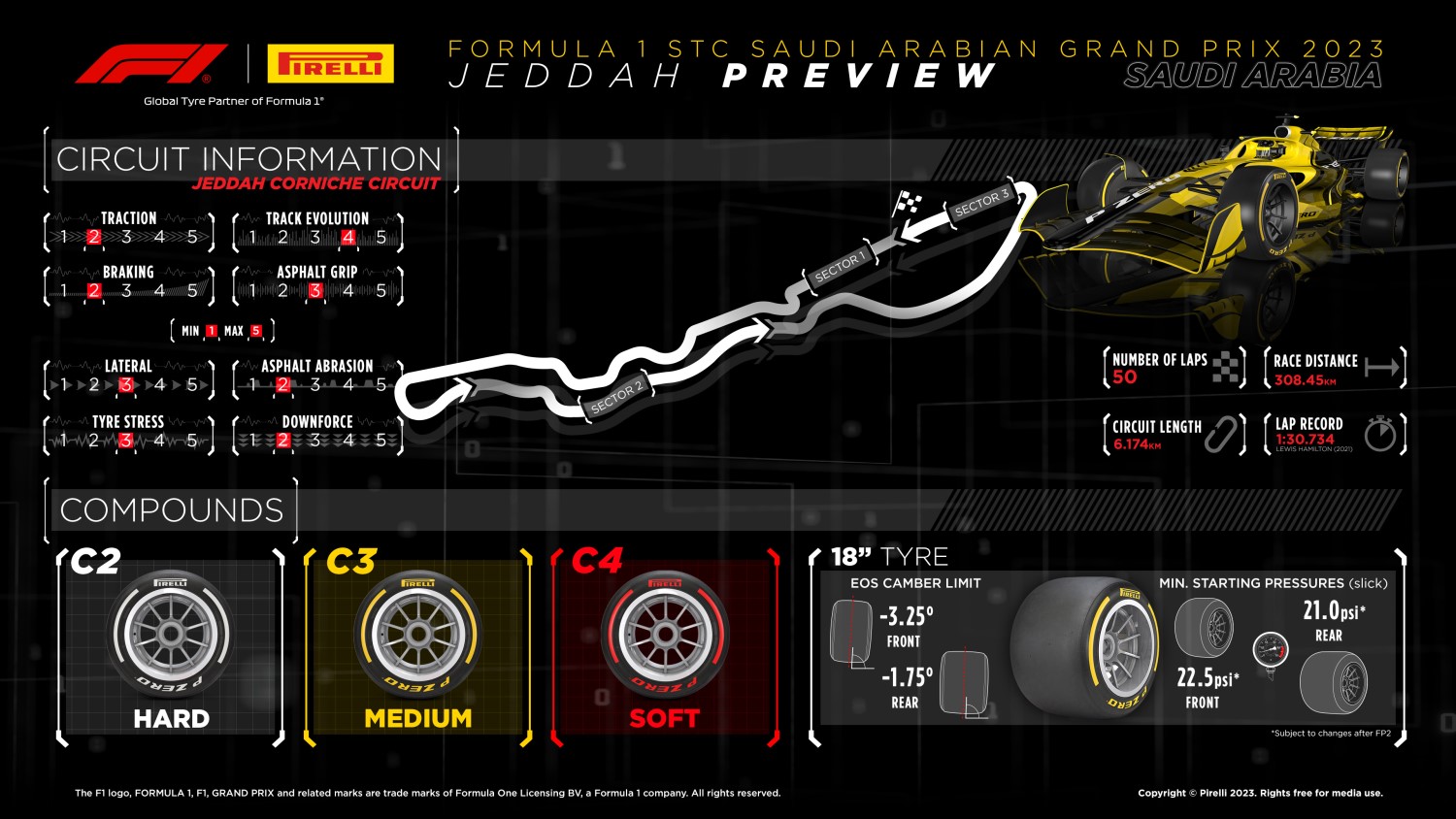F1: Saudi Arabian GP Preview
The 2023 F1 schedule will continue with Round 2, the Saudi Arabian Grand Prix, at the Jeddah Corniche Circuit this coming weekend.
Jeddah Corniche Circuit remains in its infancy, but it has already established itself as a challenging venue. Stretching out across 6.1km adjacent to the Red Sea, it is among Formula 1’s fastest circuits, with the spectacle heightened by the close proximity of the unforgiving walls.
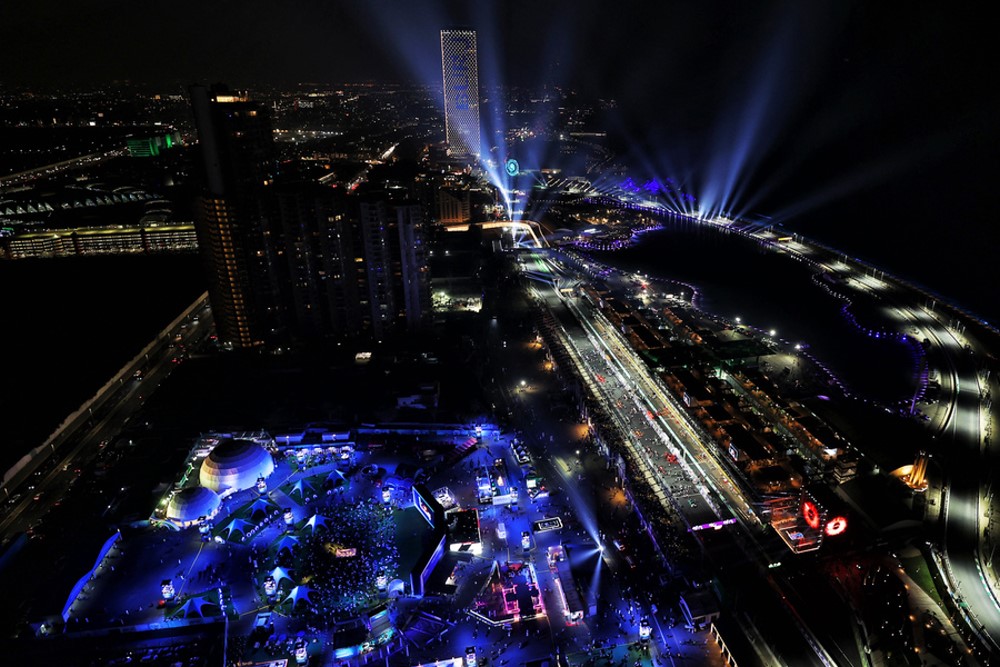
The second race of the season takes place at the Jeddah Corniche Circuit, billed as “the fastest street circuit in the world.” It has 27 corners, the highest number of any track on the calendar and is 6.1 kilometres-long, also making it the longest street circuit in Formula 1. Even though it is a temporary facility, some parts of the track, along the Jeddah seafront, are permanent.
Teams now face the challenge of quickly adapting the car to the Jeddah Corniche Circuit, which is much more sensitive to drag than Bahrain. There are a couple of tricky corners on the circuit, which seriously test the car and drivers. With each lap being in excess of 3.6 miles, there are few opportunities to practice these corners before the Qualifying session.
The key sessions take place in the evening, and teams will need to be mindful of the changes to wind and temperature following the sunset. The track surface is much smoother than in Bahrain, and Pirelli have provided softer tire compounds for this event.
There are multiple track changes this season, including special ‘rumble lines’ being added at Turns 3, 14, 19, 20 and 21, while beveled curbs have been added at Turns 4, 8, 10, 11, 17 and 23. Several of the walls have been moved back to improve driver visibility for this year’s race.
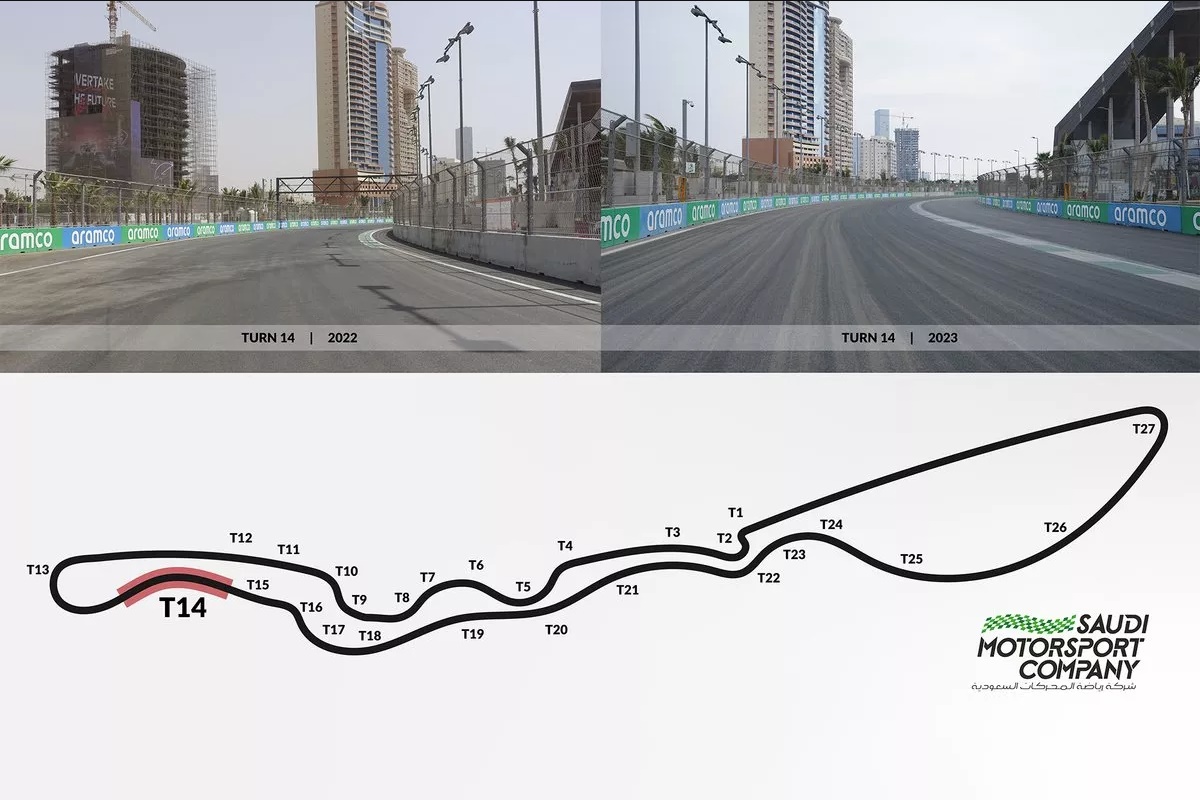
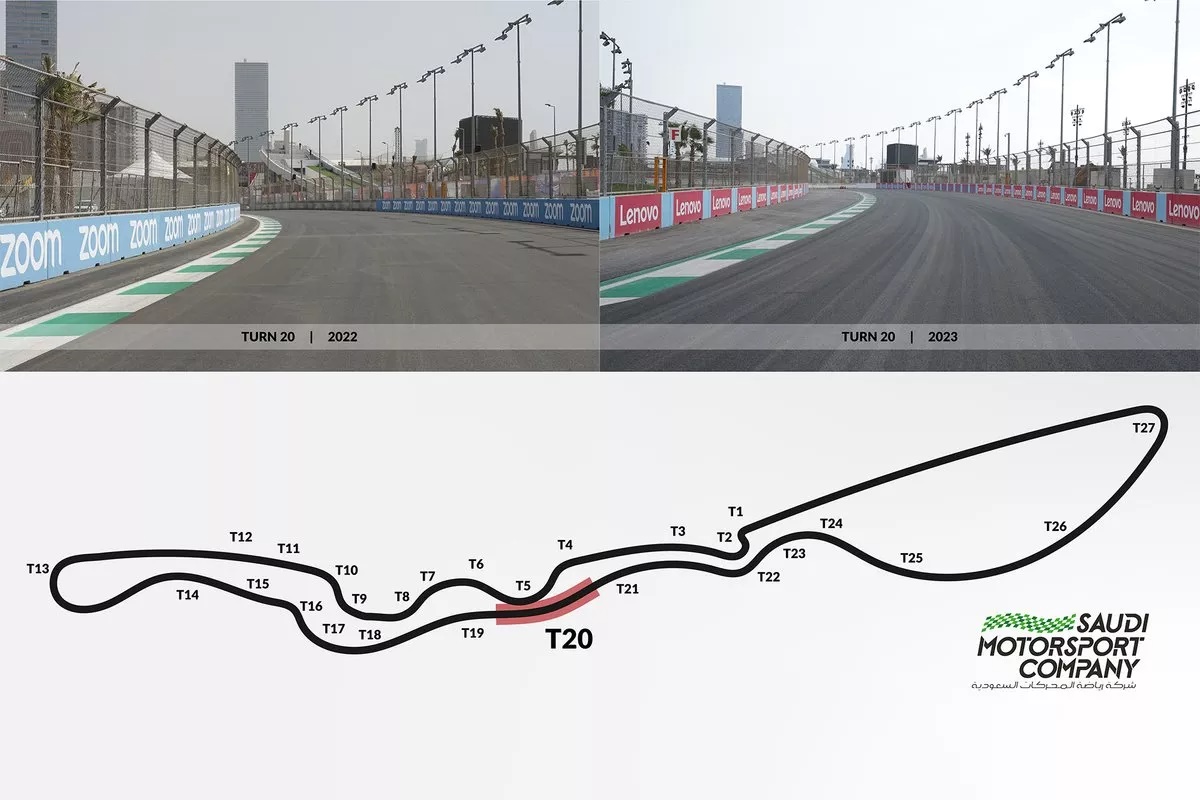
There are a lot of consequences for going over the limit, and getting close to the limit is harder than going to other tracks with run-off.”
The safety car has made an appearance in both grands prix in Saudi Arabia while 2021’s debut race was twice red-flagged because of accidents.
The infrequent use of the Jeddah Corniche Circuit means track evolution through the grand prix weekend is likely to be high, while teams and drivers must also be mindful of the changing track temperature in qualifying and the race, which both begin beneath the lights at 20:00 local time.
The track features a mix of long wide corners taken at very high speeds and narrow, twisty sections, meaning the drivers are kept very busy. The track surface provides a decent level of grip, but without being too abrasive. One can rely on the track conditions evolving considerably over the weekend, with a one-stop tyre strategy being the most likely.
Between two realms
Formula One is a sport on the move. The whole organization made an art of the camping and decamping from one corner of the globe to the other, looking for a new destination, a new race, a new thrill: doing it in an efficient, effective and sustainable way is a science in itself.
It’s not just cars, garages and equipment that are needed across the world, but everything from kitchen appliances, plates and cutlery to crates of notebooks, teddy bears and other team items for guests and fans. The logistical feats required to make this show happen are as much an impressive watch as that given by the cars on track; and the men and women making it happen are some of the unsung heroes of this sport.
Not unlike a travelling circus, Formula One is a massive family that moves from one place to the other: sometimes different, often similar, always interesting.
Saudi Arabian Grand Prix by the numbers
0.549s. The margin between Max Verstappen and Charles Leclerc in last year’s Saudi Arabian Grand Prix. There was a thrilling race-long duel for the lead between the two men which went all the way to the last lap, decided by this tiniest of margins, the smallest of the whole season.
5. The number of different leaders in the two editions of the Saudi Arabian Grand Prix. The only driver to have led both is Max Verstappen. In 2021, apart from him, Lewis Hamilton led for 18 laps and Esteban Ocon for one. Last year, apart from the Dutchman, Charles Leclerc led for 30 and Sergio Perez for six.
6. The number of UNESCO sites in Saudi Arabia. They are, the Al-Hikr archaeological site, the largest preserved site of the Nabatean civilisation; the Al-Turayf district, the first capital of the Saudi dynasty, found in the heart of the Arabian peninsula to the north-west of Riyadh; the historic center of Jeddah; rock art in the Ha’il region; the Al-Hasa oasis and the cultural area of Bir Hima, in the arid and mountainous south-west of the country on one of the Arabian peninsula’s ancient caravan routes. This is also the site of a significant collection of rock art images, depicting hunting, fauna and flora and a lifestyle that has been in continuous existence for seven thousand years.
60. The number of overtaking moves over the first two editions of the Saudi Arabian Grand Prix, split 27 in 2021 and 33 in 2022. The driver who pulled off the most passes was Lewis Hamilton on nine (2 in 2021, 7 in 2022) followed by Lando Norris on six (2 in 2021 and 4 in 2022) and Valtteri Bottas with five (3 in 2021 and 2 in 2022). Carlos has four to his name, all of them in 2021 and Charles has three (2 in 2021 and 1 in 2022).
375. The speed in km/h at which the water comes out of the Re Fahd fountain in Jeddah on the Corniche. It is modelled on the Jet d’Eau in Geneva and was inaugurated in 1985. The fountain uses water from the Red Sea and it reaches a height of 312 meters at a speed in excess of current Formula 1 car top speeds. Illuminated at night, it can be seen from everywhere in the Saudi metropolis.
Fact File: Saudi Arabian Grand Prix
- The Saudi Arabian Grand Prix is held on the Jeddah Corniche Circuit, located in a waterfront area next to the Red Sea.
- The location presents similar challenges to Abu Dhabi with sand blowing onto the track and changes in wind direction from day to night.
- The Jeddah Corniche Circuit has the most corners of any track on the F1 calendar, with 27: 16 left and 11 right.
- It is also the second-longest track we visit at 6.174km. Energy management across the lap is therefore tricky and puts more focus on the MGU-H and hybrid system performance.
- With numerous long straights, drivers spend over 80% of the lap at full throttle and the circuit is ranked first in terms of time spent, and distance covered, using this metric.
- There are six braking events across the lap with two of those designated as ‘heavy’.
- Turn 13 has a 12% gradient, with banked corners opening up more lines and helping to build momentum onto the next sweeping, high-speed section.
- Turn 2 is the slowest corner on the circuit, taken around 80 km/h, whilst the quickest are Turns 20, 21, and 26 which are taken at 300 km/h.
- Sensitivity, which describes where you find lap time, is biased very strongly towards high-speed corner performance.
- Owing to its nature as a street circuit, Jeddah has a high risk of incidents leading to Safety Cars. Across the two previous races in Saudi Arabia, there have been two full Safety Car periods, two red flags, and five Virtual Safety Car periods.
- Several track changes have been made following last year’s race “to deliver smoother, safer, and even more exciting racing.”
- These include:
- ‘Rumble Lines’ – which cause traction to be lost and slowing cars down have been added at Turns 3, 14, 19, 20, and 21.
- Steel curbs have been replaced by beveled curbs at Turns 4, 8, 10, 11, 17, and 23.
- Driver sight lines, a concern in the last two editions, have been improved with the fence wall moved back at Turns 14 and 20 by 7.5m and 5m respectively.
- The fence wall at Turns 8 and 10 have also been adjusted to improve visibility of the corner ahead.
- Turns 22 and 23 have also been amended with the fence at Turn 23 adjusted and a beveled curb added – this is expected to reduce speeds there by approximately 50 km/h.
-

DRS zones. There are three DRS zones: between turns 20 and 22; between 24 and 27 and on the start-finish straight, which means there are plenty of overtaking opportunities, unusual for a street circuit.
Race Insight
Race interruptions: With its fast nature and walls in close proximity, there has unsurprisingly been no shortage of interruptions in the Saudi Arabian Grand Prix’s short history. The inaugural race featured two red flags and four Virtual Safety Cars. Last year’s event had just one Safety Car and two VSCs.
Strategy: The C2, C3 and C4 compounds, which were used last year, return and are a step softer than the trio of tire options featured in Bahrain. Strategy is often dictated by incidents in the race, meaning teams need to be prepared for late calls into the pits for a change of tires.
Overtaking: While Jeddah Corniche Circuit features 27 corners, more than any other circuit on the calendar, there are just two significant overtaking opportunities. Turns One and 27 account for 89 percent of all passes to date. A short run to T1 at the start limits opening lap overtaking.
Unlocking the Lap
The opening sequence, Turns One and Two, is a tight left-right chicane that sets up the rhythm for the following sweeping corners. It is also where some of the overtakes in the race will occur. Getting this opening sequence right is crucial to mastering the first sector of the lap.
Turn 13 is a long, banked turn that is very easy to get wrong. It invites drivers to take more speed into the corner due to its camber, but the wall on the exit is equally as much of a deterrent. Another sequence of fast, sweeping corners follows, as well as the first of three DRS detection points.
No circuit on the calendar has more corners than Jeddah and Turn 27 – the final corner – concludes the tricky lap. It’s another big overtaking opportunity, but this turn is deceptively tight. A DRS detection point precedes the corner itself, so drivers can play tactical games to try to ensure they have DRS on the run to Turn One.

Defending Race Winner’s View – Max Verstappen
After a great start in Bahrain I don’t expect it to be an easy task in Jeddah, it is a completely different circuit and needs the car to be quick. Nevertheless, with the high-speed corners, I do believe we can have a strong car around this track. The track changes that have been made are mainly for visibility, so hopefully it has improved things a bit for us drivers, as it was definitely dangerous in some areas. It’s a really cool street circuit, with quite a lot of grip, so I always enjoy going back there to race.
Weather Forecast
As might be expected in Saudi Arabia, the weather is expected to be dry and hot – daytime temperatures of around 30 degrees Celsius will give way to slightly cooler conditions in the low 20s as night takes hold.
On Friday, FP1 gets started at 1630 local time, with conditions set to be hot with 30 degrees air temperature and humidity of 55%.
The later FP2 session, which will be more representative of the weather conditions for Sunday’s Grand Prix, will have seen the temperature drop by around five degrees but a humidity increase to around 70%.
On Saturday, FP3 will begin at 1630 local time again, with an air temperature of 31 degrees waiting for the drivers to head out for the final hour ahead of qualifying.
Temperatures will cool off to around 22 degrees Celsius for the all-important qualifying session, which gets started at 2000 local time.
A hot and dry Sunday awaits which, thankfully, the drivers won’t have to worry about as the Saudi Arabian Grand Prix gets started at 2000 local time.
Air temperatures of around 20 degrees await at that time of the evening, and there’s a less than 1% chance of rainfall affecting the Grand Prix.
Tires
Mario Isola – Motorsport Director
“It’s vital to find the right setup and be ready for anything at Jeddah: a track that’s very different to Bahrain”
“For the rapid Jeddah track, we have confirmed the same compound choices as last year as they showed very good consistency throughout the race weekend. In the two races held up to now, the Saudi Arabian Grand Prix has been quite unpredictable because of the frequent safety cars and neutralization, being a typical street circuit. A one-stopper was the fastest option in 2022, when a safety car led to an early pit stop for most of the drivers, who went on to finish the race on the hard tire. Max Verstappen and Charles Leclerc fought hard on this strategy thanks also to the durability of the tires, with the Red Bull driver winning by less than a second at the end of a great race. The teams will also have to work hard on car setup because they will only have free practice to fine-tune the balance on this track with the latest tires. The first race in Bahrain was all about traction and braking but Jeddah instead focuses on lateral forces, with completely different characteristics to Sakhir.”
THE TIRES ON TRACK
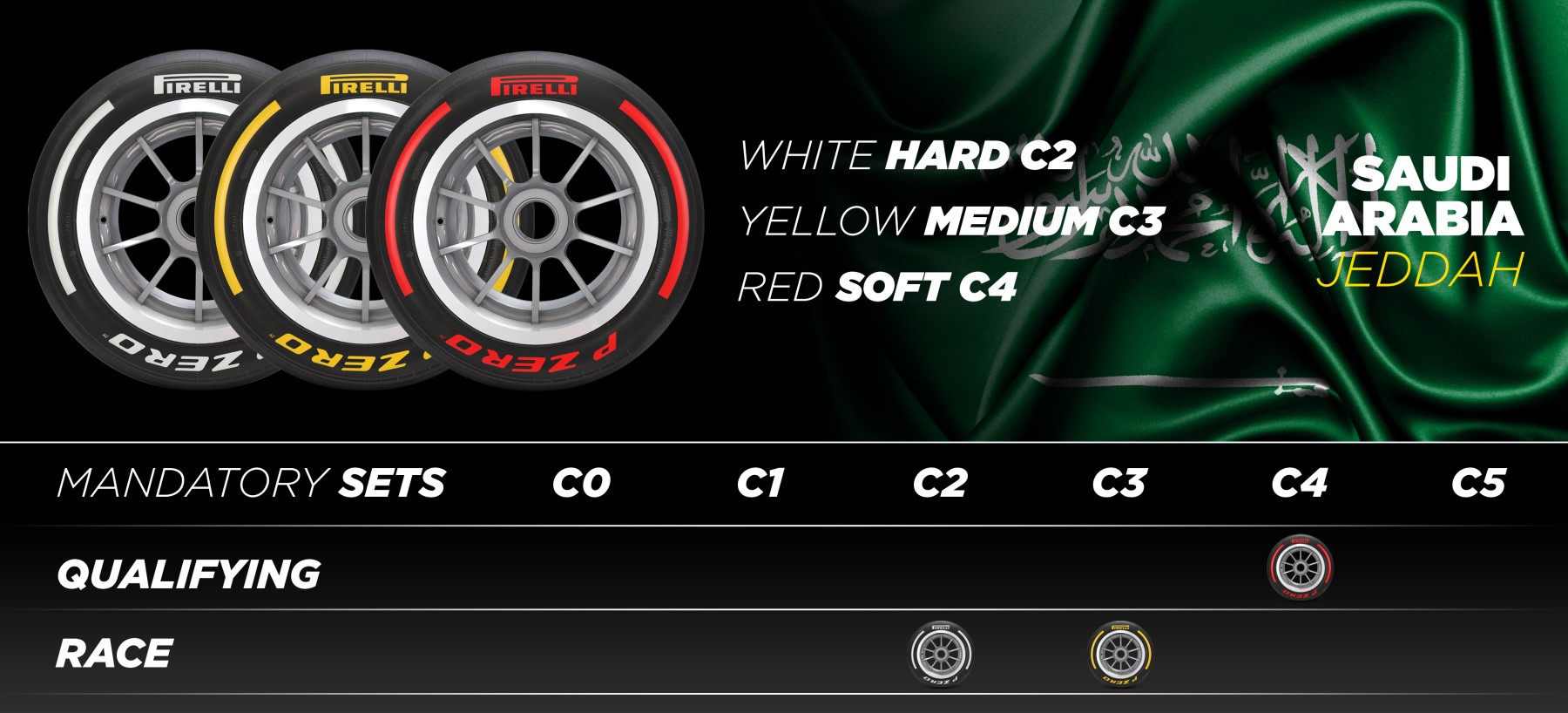
- For the Saudi Arabian Grand Prix, C2 is the P Zero White hard, C3 is the P Zero Yellow medium, and C4 is the P Zero Red soft.
- Jeddah is the fastest street circuit of the year. The track was designed three years ago and has been continually improved since then. This year, there are some new rumble strips on the escape roads while some of the curbs have been smoothed. A number of the walls have been repositioned, such as those at Turns 8 and 10 (to improve visibility on entry) and Turn 23 (to slow the corner down).
- Car setup will be very different to Bahrain. For Jeddah, it’s important to have good stability throughout the fast corners that characterize the track.
- The circuit offers a medium level of grip but the sand blown onto the surface can influence this on the low-abrasion asphalt. The track, which overlooks the Red Sea, is not especially demanding in terms of traction and braking, with lateral forces predominantly affecting the tires.
- As was the case in Bahrain, this will be another night race – but the start takes place two hours later, at 20:00. This is the same time that qualifying and FP2 is also run. Temperatures are expected to remain largely consistent throughout each of these sessions as well as the race. The other free practice sessions are scheduled for late afternoon, in asphalt temperatures that can easily be 10 degrees hotter.
